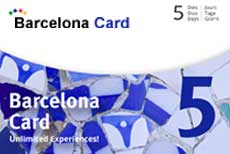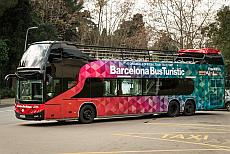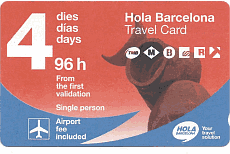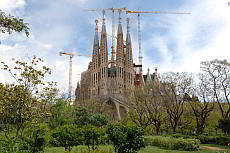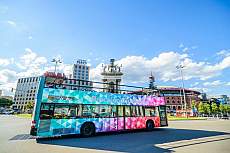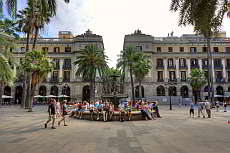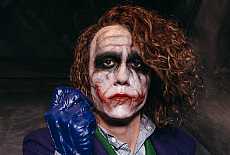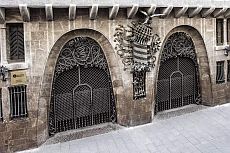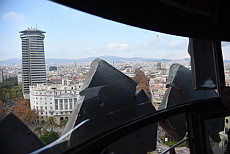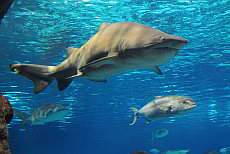Las Ramblas
Barcelona's famous promenade
The Rambla is one of the most famous and vibrant landmarks in Barcelona. This approximately 1.3-kilometer-long promenade runs from the central traffic hub Plaça Catalunya to the Old Port. The wide pedestrian zone in the middle invites you to stroll and is the heart of the Rambla.
Content of this page
At the end of the promenade on the mainland stands the highly visible Columbus Monument. From its observation deck, you have a wonderful view of the old town and the harbor. The promenade continues over the Rambla de Mar, a curved wooden bridge built in 1994, extending the historic Rambla to the Maremagnum shopping center.
The Rambla is divided into several sections, which is why the plural "Las Ramblas" is often used. Each section has its own character, and the promenade divides the old town into the Barri Gòtic and the Raval, two of Barcelona's most notable neighborhoods. In these districts, you will find some of the city's most exciting attractions.
There's always something happening on the Ramblas: street musicians and artists entertain visitors, people pick up their newspapers at kiosks, families with children buy treats from ice cream shops that have replaced the former animal stalls, and older gentlemen sit by the roadside to watch the bustling activity.
Few places in Barcelona are used as much by tourists and locals alike as the Ramblas. They are an integral part of Barcelona's urban life.
Sections of the Ramblas
- Rambla de Canaletes: The upper part of the Rambla begins at the Plaça Catalunya. It was named after the Font (source) de Canaletes, where a fountain stands today.
Popular belief says that whoever drinks from this fountain will always return to Barcelona. However, the truth is that it’s more likely the charm of the Rambla that attracts people – not the chlorinated water.
At the beginning of the Rambla, there are chairs on both sides, inviting a short rest. - Rambla dels Estudis: The next section of the Rambla is named after the university that was once located here, which was demolished in 1843.
A more fitting name for this section of the Rambla is surely the also commonly used name, Rambla del Ocells ("Bird-Rambla"). In the past, numerous vendors sold songbirds and other small animals like guinea pigs or turtles here. This had little to do with appropriate animal care, so the animal vendor booths were gradually replaced by ice cream and sweets stands.
At the end of this section, to the right at the corner of Carrer Carme, stands the Gothic-Baroque Jesuit church Església di Betlem. On the opposite side is the Palau Moja, an 18th-century noble palace where exhibitions are occasionally held. - Rambla de les Flors: Heading towards the sea, the sweets kiosks are now replaced by flower vendors. In the 19th century, this was the only place in Barcelona where flowers were sold.
To your right (if facing the port) is the Mercat de la Boquería, Barcelona's largest market. A visit is worthwhile even if you have no intention of buying anything. On the opposite side, you can see a former umbrella shop, Casa Bruno Quadros. This alone is somewhat bizarre, but what is interesting is the facade adorned with copper umbrellas and a dragon. - Pla de L'Os: Between the Rambla de les Flors and the Rambla dels Captxis is the Pla de l'Os – the Bear Square, so named because of the jugglers who used to make bears dance here.
On the not particularly remarkable square, there is a mosaic by Joan Miró, which he created in 1976. You will find Pla de L'Os at the height of the Liceu metro station. - Rambla dels Caputxins: This part of the Rambla is primarily the Rambla of street performers, living statues, and cafes.
Here, artists meet to showcase their tricks. Sometimes the presentations are banal, but often you also get to see real small-scale art that you would pay a lot to see elsewhere.
On the right side is the Gran Teatre de Liceu opera house, outwardly rather unassuming but very lavish inside. After being completely destroyed in a fire on January 31, 1994, and rebuilt, it now hosts the largest Wagner festivals outside of Bayreuth. - Rambla de Santa Mònica: On the last section of the historic Rambla, right before the port, you will find souvenir stands and art dealers, as well as painters who will draw you as a caricature. In the past, this part was strongly influenced by the character of the nearby red-light district of the Barrio Chino in the Raval district. Fortunately, this slightly seedy character has disappeared from the lower part of the Rambla.
To the right, in a former convent from the 17th century, is the Museum Centre d'Art de Mónica. It hosts changing exhibitions of contemporary art.
Diagonally opposite, in a tiny side street, lies the Wax Museum. - Rambla de Mar: The Rambla de Mar, built in 1994, is not a historic part of the Ramblas. From the Rambla de Santa Mònica, cross the Passeig de Colom past the Columbus Monument to reach the harbor pier. From there, an impressive, wave-shaped wooden bridge leads to the Moll d'Espanya in the center of the harbor basin. Here lies the entertainment complex Maremagnum with boutiques, cafes, restaurants, and cinemas, as well as the Maritime Museum.
The iron Columbus Statue is an excellent place to get an overview of the Rambla and the harbor. From up there, you have a beautiful view...
Sights and experiences on the Rambla
- The double-decker tourist buses are not really part of the Rambla's scenery. However, there is a stop at each end of the promenade: at Plaça Catalunya and at the Monument de Colom.
- 2 different routes
- Tickets for 1 or 2 days
- Unlimited Hop-On/Hop-Off bus ticket for the selected period
- Operating hours: 09:00 - 19:00 (last departure from Plaça Catalunya)
No service on December 25 and January 1 - All buses are wheelchair accessible (lower deck)
- Choose from the Gold or Diamond menu and enjoy a meal at one of the most iconic restaurants
- Skip-the-line access to the Hard Rock Cafe Barcelona
- Gold Menu: Choice of main course; brownie; and drink of your choice
- Diamond Menu: Choice of starter (fresh salad or small onion rings), choice of main course, choice of drink (coffee or tea), and chocolate cake
- The MACBA in the Raval district houses an extensive collection of modern and contemporary artworks from around the world, reflecting important art movements and trends of the 20th and 21st centuries.
- The MACBA building itself is a work of art. With its striking modern architecture and interplay of light inside, it offers an impressive setting for the exhibited works.
- Contrast in the Raval district: Modernity and Medieval.
- The Mercat de la Boqueria delights all senses: visually stunning, unique smells, and you can enjoy the delicacies at the restaurants and stalls.
- The Mercat de Boqueria is famous for its impressive selection of fresh foods, including fruits, vegetables, seafood, meat, cheese, and much more.
- In addition to the food stalls, the Mercat de Boqueria also features numerous small restaurants and tapas bars.
- The Mercat de Boqueria is one of the oldest markets in Barcelona and has a long history.
- With interactive exhibits and a humorous approach, the Erotic Museum offers an entertaining and educational experience that encourages visitors to smile and reflect.
- The museum features erotic artworks, photographs, and sculptures that are both provocative and artistically valuable, providing a new perspective on a often tabooed subject.
- The Erotic Museum boasts a fascinating collection of over 800 exhibits that shed light on the history and culture of erotica from various epochs and cultures.
- Plaça Reial is known for its elegant Neoclassical architecture. The enclosed arcades, impressive buildings, and the lanterns designed by Antoni Gaudí give the square a unique, historical atmosphere.
- During the day, the many restaurants and cafés invite you to relax, while the square becomes a center of nightlife in the evening, with numerous bars and clubs in the vicinity.
- Plaça Reial has a rich history and was once a royal garden. Today, it reflects Barcelona's vibrant cultural heritage and serves as a symbol of the city's social and urban development.
- The Wax Museum in Barcelona is a fascinating attraction.
- The museum features over 300 wax figures representing historical personalities, famous artists, literary characters, and pop culture icons. The variety of figures allows for an entertaining and educational tour through different eras and cultures.
- The museum is housed in a magnificent 19th-century building, adding a special, almost mystical atmosphere to the visit. The intricately designed scenes and atmospheric rooms enhance the experience.
- In addition to the wax figures, there are interactive elements and creative displays that allow visitors to immerse themselves in the depicted worlds. This makes the museum an exciting and varied attraction for all age groups.
- The Palau Güell is an impressive work by Antoni Gaudí and a highlight in Barcelona.
- The palace is one of the early works of the brilliant architect and showcases his unique design skills.
- The luxurious and artistically designed rooms, including the roof and entrance hall, are breathtaking.
- Palau Güell is a UNESCO World Heritage Site.
- Barcelona is naturally closely connected to maritime activities, and the Museu Marítim showcases this in a very impressive way.
- The museum features stunning replicas of historic ships, including a life-sized model of the royal galley of Don Juan de Austria.
- The museum is housed in the impressive medieval Royal Shipyards (Drassanes Reials), one of the finest examples of civilian Gothic architecture.
- The exhibits offer fascinating insights into the maritime history of the Mediterranean and Barcelona's role as a significant port city.
- The Columbus Monument is located at the end of La Rambla, near the harbor and Rambla de Mar, making it easy to include in a city exploration.
- The monument's observation deck offers a stunning 360-degree view of the city, the sea, and the harbor.
- The monument honors Christopher Columbus and his return to Barcelona after his discovery of the Americas. It is an important symbol of the city.
- The Golondrinas offer an excellent opportunity to view Barcelona's impressive skyline and famous landmarks such as the Columbus Monument, Montjuïc, and the harbor from a new perspective on the water.
- A boat trip along Barcelona's coast is a relaxing way to escape the hustle and bustle of the city, enjoy the fresh sea breeze, and unwind.
- Riding the Golondrinas is a fun experience that delights both children and adults. It's a pleasant opportunity for a relaxing break from the city's hustle.
- Sail along the coast aboard Barcelonas new eco-friendly catamaran.
- 1-hour boat tour on the catamaran
- The catamaran departs from Port Vell, where you can see landmarks such as the World Trade Center, the largest yachts, and the Olympic Port
- The Aquàrium de Barcelona features an impressive 80-meter-long underwater tunnel. You'll feel as though you are in the middle of the ocean, surrounded by sharks, rays, and a variety of colorful marine life.
- With over 11,000 animals from 450 different species, the aquarium offers a fascinating diversity of marine creatures from the Mediterranean and tropical waters, making it an exciting and educational experience for all ages.
- The aquarium also offers many interactive exhibits and programs, such as the opportunity to observe the feeding of the animals.
History of the Rambla
The history of the Rambla is closely linked to the development of the city:
- Origins and significance of the name: The name "Rambla" comes from the Arabic word "ramla," which means "sandy riverbed." Originally, the Rambla was indeed a dry riverbed that channeled water from the nearby hills towards the sea.
- Development into a promenade: In the Middle Ages, the Rambla marked the western boundary of Barcelona's then city walls. The street separated the city from the neighboring Raval, which was largely undeveloped at that time. Between the 15th and 18th centuries, monasteries and religious institutions were built along the street. Some of these buildings, like the Monastery of Sant Josep, later gave the Rambla its characteristic markets and squares, such as the Mercat de la Boqueria (Mercat de Sant Josep).
- Transformation into a grand avenue: From 1704 onwards, the Rambla was increasingly urbanized as part of Barcelona's expansion and modernization. The construction of boulevards and the creation of squares turned the Rambla into one of the city's main thoroughfares. During this time, many of the historic buildings that still exist today were erected. In the 19th century, the Rambla became a popular promenade for Barcelona's residents. With the growing importance of bourgeois life and the modernization of the city, trees were planted and public squares were designed, giving the Rambla its current character.
- Modern developments: In the 20th century, the Rambla underwent extensive modernization. New buildings, restaurants, and shops contributed to making the Rambla the social and cultural heart of Barcelona. Major events such as carnival celebrations, political demonstrations, and public festivals took place here. Especially during the Franco regime, the Rambla became a place of quiet protest and cultural expression.
- The Rambla today: On August 17, 2017, attackers carried out a terrorist attack on the Rambla, killing 14 people and injuring over 130. Despite this tragic event, the Rambla remains Barcelona's most popular promenade and a symbol of freedom and openness. Today, as in the past, it is a vibrant meeting place for locals and visitors who enjoy Barcelona's atmosphere and use the place to linger and explore. The Rambla shows that the city has preserved its warm and welcoming nature.
The history of the Rambla reflects Barcelona's development from a medieval city to a modern metropolis. Despite many changes, it has always remained a central part of urban life.
Why visit the Ramblas
The question of why one should visit the Ramblas doesn't really arise: You will pass by it anyway – so you might as well stroll along the Rambla.
Our Tip
Experience the Rambla rather "casually." Walk along the promenade, visit the sights on both sides of the Rambla, take a look into the Raval and Barri Gòtic neighborhoods, enjoy the food in one of the restaurants, and watch the bustling activity on the street.
The Rambla offers a very special atmosphere: The melting pot of street artists, musicians, museums, and markets creates a lively and tangible cultural experience. Along the Rambla, there are also numerous historic buildings, such as the Gran Teatre del Liceu and the Mercat de la Boqueria.
Culinarily, the Rambla also has a lot to offer. In the numerous restaurants and cafes, you can enjoy local and international cuisine while watching the bustling activity. Shops, from souvenir stores to boutiques, line the street and invite you to browse.
The Rambla is a place where locals and tourists alike can experience the diverse life of Barcelona up close.
Exciting things along the Ramblas
Important information
Surroundings
Find Hotels nearby
Address
Arrival
Metro: Plaça Catalunya (L1, L3), Liceu (L3), Drassanes (L3)
Bus Turístic: Plaça Catalunya / Colom - Museu Marítim
Parking nearby
Opening times
open to the public
Tips for the visit of the Ramblas
Be sure to explore the Barri Gòtic and Raval neighborhoods to the right and left of the Rambla; it's worth it. There's a lot to discover.
Unfortunately, pickpockets also frequent the Ramblas. Follow a few safety tips, and you'll have little trouble with these thieves.
Book your accommodation in Barcelona here! All categories.
1-5*-hotel rooms, apartments, hostels.

